There are many different types of Billiards games. If you are bored of 8-ball, you are encouraged to try your hand at some of the more unique variations of billiards discussed here.
Billiards games can vary widely. Take, for example, straight pool, which involves a continuous style of play much unlike that seen in other common billiards games. Players of 8-ball will also find Snooker to be unique since a points system is applied to the individual object balls.
Here you will find out what makes Billiards games so great. You will also learn about how you can convert your standard pool table to be ready for a lot more than just a rousing game of 8-ball. Even 9-ball and 10-ball pool are unique by comparison, as they require the player to aim for the lowest-numbered object ball on the table.
Table of Contents:
8-Ball
9-Ball
10-Ball
Straight Pool
One Pocket
3-Cushion
English Billiards
Snooker
8-Ball
This version of billiards is played with a single cue ball and fifteen object balls that are numbered 1 to 15. The object balls numbered 1-7 are solid colors while the ones numbered 9-15 will be striped. As a result, players are divided into teams based upon whether they are trying to get the stripes or solids into the pockets.
The game starts out with the players racking the balls. The racking must be set up in a specific way and require the use of a pool ball rack like this one.
Here is how the pool balls are arranged in the triangle rack:
- The 8-ball is in the center of the triangle
- The first ball is placed on the foot rack (the bottom of the triangle)
- A striped ball is placed in one corner of the rack
- A solid ball is placed in the opposite corner
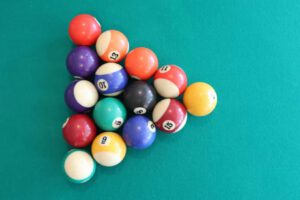
The object of the game is to get either all the solids or all the stripes pocketed. Players will continually have turns until they have a turn in which they fail to pocket any of their designated colors. This means that a player who is “stripes” will keep shooting until they do not pocket a striped ball. Then the opponent will get their chance.
The final step will involve shooting the 8-ball into a pocket that the player calls. If the 8 ball finds its way into a pocket prior to this, then the player who was taking the shot will automatically lose the game.
There are a few more penalties or fouls in the standard 8-ball pool game:
- Pocketing the cue ball on a break
- Hitting an object ball off of the table
The advantage of 8-ball pool is that it is a game that just about everybody has played at some point. The rules are pretty simple and straightforward for standard play. Rules may be a little more stringent in competition play, but the standard version of this game is great for parties.
9-Ball
9-ball pool is a fun alternative to 8-ball pool in which players attempt shots at the lowest-numbered ball that is currently on the table. The balls do not necessarily need to be pocketed in numerical order, but the first player to pocket the 9 ball is the winner.
The 9-ball game is set-up with a diamond rack:
- The 1-ball is placed at the front-facing point of the diamond
- The 9-ball is placed in the center of the diamond rack
- A coin can be tossed to decide who breaks the rack
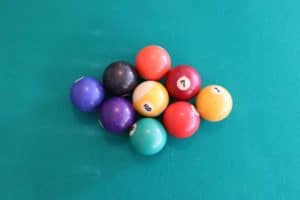
The cue ball is placed behind the head string for the break to occur. The rules call for the breaker to hit the 1-ball at the front of the rack first. The breaker must either pocket a ball or move at least four of the balls to the rail. Otherwise, the next player will get their turn to take a shot.
Players will continue to get turns until they do one of the following things:
- Fail to pocket a ball
- The player commits a foul
- The game is one because the 9-ball has been pocketed
Fouls in 9-ball include:
- None of the 8 object balls hit a rail after a player shoots
- The 3 foul rule: if a foul is incurred on 3 straight turns, then the game may be ended, and the player committing the fouls loses the game.
10-Ball
The object of this billiards game is to pocket the 10-ball. The only items on the table in this game are the object balls numbered 1-10 and the cue ball. This game is more difficult to play than the other standard versions of pool. As such, players with a higher skill level will likely find the game much more enjoyable than novice players will.
What makes 10-ball pool more difficult than other billiards games is the fact that the player cannot win the game if they pocket the 10-ball via a break shot or combination shot. Winning this game requires a little bit more finesse than what you see in an 8-ball or 9-ball pool game.
How many different players can play? This game can be played by either 2 individual players or teams of 2 players. The game has a tendency to fly by pretty quickly and, as such, is not really designed to be played between two crowded teams.
A standard triangle rack is used, and the field is arranged as follows:
- The 1-ball is placed at the apex of the triangle
- The 2-ball and 3-ball are placed in opposite corners of the bottom line
- The 10-ball is placed in the center position (in the row that is second from the bottom of the triangle)
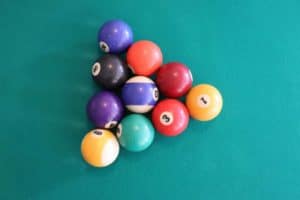
There are special breaking rules in the 10-ball game:
- At least one object ball must be contacted, and a ball pocketed
- Or at least 4 object balls must be driven to the rail of the pool table
- The penalty for not doing so offers the opponent the choice of either continuing to play as is or requesting a re-rack
The rules of the game are very similar to the rules of 9-ball billiards. The cue ball must meet the lowest numbered object ball on every shot. The resulting penalty for the failure to do so is that the player will lose their turn.
Straight Pool
This style of billiards is also commonly referred to as continuous pool. Any object ball may be pocketed during a shot. There is no requirement for a player to score either solids or stripes exclusively. Players score a point for each object ball that is pocketed. You will find that this style of play is much different than what you are used to in other billiards games.
Here’s what’s different with straight pool:
- The object of the game is not to pocket every single object ball
- Rather, the players will pocket each object ball until only one object ball and the cue ball remain
- At this point, the players will re-rack the other 14 balls
- You will then try to pocket the remaining ball while also breaking the rack in the center
This game is called straight pool or continuous pool because the game will continue to go on until one of the players reaches a set score. The winning score will be chosen before the game by the players.
One-Pocket
This is a variation of billiards in which each team selects a specific foot pocket to target. Both teams can select different pockets. It is not possible for both players to target the very same leg.
All of the balls numbered 1 to 15 are used in this game. The game is started with a break from a triangle rack. There are no specific requirements as far as racking order. The balls can be racked in any order. The breaker will be responsible for selecting their foot pocket. The opposing player must choose the remaining foot pocket.
The breaker must do at least one of the following to continue their inning:
- Pocket a called ball
- Hit the object balls in the rack
- Cause the cue ball to at least hit the rail after hitting the object balls in the rack
- Failure to do so will result in a 1 point penalty
Players continue their inning, provided that they pocket a called ball with every turn. Players win the game if they have reached a point where they have legally pocketed 8 called balls. Players also automatically lose if they happen to commit fouls in three consecutive innings (or turns).
3-Cushion Billiards
This game is drastically different from the billiards games that people are likely most familiar with. First of all, it requires the use of a pool table that does not have any pockets. This doesn’t mean that you have to buy a special pool table to play 3-cushion billiards. Instead, you can purchase pocket inserts to convert your table into one that is suitable for play.
You will need 2 cue balls to play this game:
- One player/team will shoot with the white cue ball
- The other player/team will shoot with a yellow cue ball
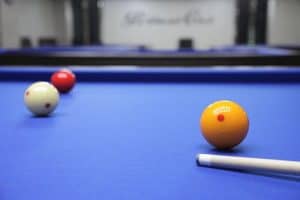
Here are the gameplay rules:
- In order to score a point, the player’s cue ball must strike at least 2 object balls and at least 3 cushions, all from one shot
- This must happen in a particular order that will be discussed in further detail below this bullet section
- Players will continue to shoot until they miss; then it will be their opponent’s turn
- The standard rules say that the first player to reach 40 points will win the match
- You are certainly welcome and encouraged to set lower score limits if you and your opponent are new to the game
The official United States Billiards Association rules state that the cue ball absolutely must hit three cushions before hitting the second object ball. There are a variety of ways that this can happen, as is discussed in the official rules. If you are a novice to the game, you are always welcome to adopt simpler rules, provided that your opponent agrees beforehand.
This game requires players to be a lot more accurate with their shots. Novice players can use 3-cushion billiards as a practice exercise to get better at their shots. This game teaches billiards players how to be more purposeful with their shots, a skill set that will lead to noticeable improvements when they play billiards games like 8-ball pool.
English Billiards
English billiards is played on a table with different dimensions than that of the pool table used for games like 8-ball and 9-ball pool. If you are going to play this game, then you will need a 6 x 12-foot snooker table.
Materials needed to play English Billiards include:
- A cue ball for each of the 2 players- one white and one yellow
- A red object ball
The game is started with a red ball being placed on a designated spot on the table. At the start of the game, only the starting player’s cue ball will be on the table.
There are three ways to score points in English Billiards:
- A cannon is worth 2 points
- A hazard in/off the cue ball is worth 2 points, and a hazard in/off the red is worth 3 points
- Potting the cue ball is worth 2 points; potting red ball is worth 3 points
A cannon occurs when one player’s cue ball strikes the opponent’s cue ball and the red ball in the same shot.
There are limits on both the number of hazards and cannons that may be made consecutively. Only 75 cannons may be made consecutively before a foul occurs, and only 15 consecutive hazards may occur without a cannon. This unlikely to occur during an amateur game, but these rules help keep the game competitive during tournament play.
Snooker
Snooker is more similar to English Billiards than it is to the other Billiards games discussed here. The game is played on a 6 x 12-foot English Billiards Table. You will also find smaller tables that make play easier. This includes the popular 5 x 10-foot billiards table.
Materials needed to play Snooker include:
- 15 solid red object balls
- 6 object balls of varying colors (not numbered)
- Cue ball
Setting The Game Up (see diagram here):
- The red balls are arranged in a triangle rack
- The pink object ball is placed as close to the apex of the red balls as possible
- The blue object ball is placed in the center of the table
- The yellow, brown and green balls are placed in the listed order from top to bottom
- The black ball is placed near the bottom of the triangle of red balls
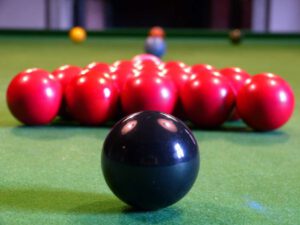
The game of Snooker is a little bit different from other Billiards games in the way that the playing surface is divided into different sections. The baulk-line is a straight line that is drawn 29 inches from the face of the bottom cushion. Parallel to this line is the baulk.
The half-circle is a semi-circle that is placed in the center of the line and has a radius of 11.5 inches. If the striker has the cue ball within the half-circle, then the cue ball can then be placed anywhere on the line or within the half-circle.
The object of the game is simply to score more points than the opponent. Each of the color object balls is worth an increasing number of points as follows: red-1, yellow-2, green-3, blue-5, pink-6, black-7.
There a couple of ways that players can score points:
- By legally potting object balls or red balls
- The red balls are worth 1 part
- By being awarded points as a result of fouls being committed by the opponent
The only requirement for breaking is that the cue ball hits at least 1 red ball. There is no requirement for a ball to be pocketed, nor is there a requirement for any number of object balls to hit the rails of the table.
Strikers have to alternate between red and color object balls as long as both are on the table. Potting a color ball when it is the striker’s turn to hit the red ball counts as a foul, and vice versa. If the color ball is the target, then the striker must either call which object ball they want to hit, and they must cause the cue ball’s first contact to be a color object ball.
One of the main differences between English Billiards and Snooker is the fact that cannons do not score any points. The cannon still exists as a useful maneuver despite the fact that the player does not directly score any points from this outcome. This is because it allows the player the chance to gain or improve positioning so that a scoring opportunity may arise during their next turn.
What Is the Best Billiards Game for A Beginner?
If you are new to billiards, you are encouraged to try one or more of these games:
- 8-ball pool
- 9-ball pool
- 10-ball pool
- Straight Pool
Games like one-pocket and three-cushion pool require the player to spend more time thinking about strategy if they are going to score any points at all. Games like 8-ball are popular at parties where the novice players don’t have to think much about strategy at all. When people are looking for table games to add to their home, a pool table is one of the most popular choices by far.
In fact, learning how to play 8-ball pool is no different than learning how to play popular card games like poker. At some point in your life, you will be invited to at least one party where a rousing game of 8-ball pool is started.
Less common billiards games like 3-cushion are a great way to expand your skillset if you are already familiar with the basic fundamentals of 8-ball pool and that class of billiards games. The more unusual billiards games will certainly elevate your skill level when you go back to playing the more conventional games.
What Is the Hardest Billiards Game to Play?
Those looking for more of a challenge are encouraged to try their hand at the billiards games discussed in this section. These games can serve to sharpen your shooting skills. You will have to be a lot more careful about how you aim your shot.
One-Pocket
One-pocket pool certainly deserves a spot in the discussion of hardest pool games to play. The game requires the players to shoot 8 balls into the foot pocket of their choice (the pockets on the end of the table.) this game requires the player to be accurate with their shots. It is especially difficult because all 15 object balls are racked in the center.
Three-Cushion
Three-cushion billiards also requires a high level of skill and, as such, is typically only played by those who have mastered their shot. This is because of the strict scoring rules. To even be able to score a point, the cue ball must strike at least 3 cushions and at least 2 object balls.
The cue ball must hit three cushions before hitting the second ball. This is the detail that makes this game so difficult, as the player needs to plan their shot out in their head and then execute the plan without failure consistently enough to beat their opponent.
Can I Play Snooker On A Pool Table?
One of the perceived downsides of the different sets of rules is the fact that games like 8-ball pool are played on tables of different dimensions than the snooker table. This leads to the impression that it is not possible to play Snooker on the 8-ball pool table that has become standard in many American households.
Fortunately, there are ways to convert an 8-ball pool table to a snooker table. You can easily add the lines for Snooker to your pool table using chalk or permanent felt tip markers. Be advised that the typical home table for 8-ball pool is 8 feet in length, while a standard Snooker table is 12 feet in length.
The lines that you will need to include are:
- Baulk line: a straight line that is drawn 29 inches from the face of the bottom cushion
- Half-Circle: a semi-circle located along the baulk line, the radius is 11.5 inches
- You are also welcome to mark out the spots on the playing surface where the object balls are located, although this is not necessary
Playing on the shorter pool table will alter the gameplay a little, but you will still have the opportunity to play a game that has a different feel to it if you are bored of playing 8-ball pool all the time.
How Much Room Do I Need For A Pool Table?
Now that you’ve learned about the most popular billiards games, you are probably interested in getting a pool table for your home. There are different types of tables on the market, so be sure to measure the dimensions of your planned hobby space before you commit to a table.
Billiards dimensions are as follows:
- Standard Household Pool Table
- Great for 8-ball, 9-ball & 10-ball but can be adjusted for Snooker and other games as well
- 90-100” inches in length depending upon the variant
- 53.5 inches wide and 32 inches high
- 7’ Foot (Bar Box) Pool Table With Automatic Ball Return
- The model linked above includes the automatic ball return feature
- 84” x 46.5” x 31”
- Great for those who barely have enough room to fit the standard pool table
- 6’ Foot Pool Table /Table Tennis Combo
- Great for households limited on space that can’t decide on whether they want a billiards table or ping-pong table
- 72 inches x 38 inches x 31 inches
- Half the size of the normal Snooker table
The final thing that you will need to take into consideration is the amount of room you have to play. You certainly do not want to be left banging the pool cue against the wall. Colorado State recommends adding the length of a cue (58 inches) plus another 6 inches for added comfort on the backswing.
Designate any less space than this for your pool table, and you’ll likely run into problems. Having to settle for a pool table that is 7 feet or less in length should not limit gameplay too severely. It may even be able to shoot on a bar box table since the corner pockets are known for being more forgiving on these types of tables.




